It was during my show-hopping around Tucson while looking at gems that I learned AGS Conclave was going to be held in Nashville this year! I was immediately excited because that meant I didn’t have to travel very far to attend and I was also eager to show everyone how awesome Music City is (and hopefully people would understand why I don’t want to move to LA or NYC). I love Nashville and AGS did a great job choosing this city as their 2018 location, and from talking with several people at Conclave, many ended up planning a mini-vacation to coincide with the conference, which really says a lot!
With most trade shows or jewelry events, I feel like I am always in a hurry–I have appointments to be present for and usually rushing to make them on time, and I don’t have too much time to carry a meaningful conversation. AGS Conclave was the exact opposite of all those feelings for me this year and although a lot probably had to do with the overall fact that everyone there was there to learn, connect and network rather than sell, pitch or bait, I also think Nashville’s laid back vibe also rubbed off onto the event’s ambiance. It was simply FUN and I love learning, so getting the class schedule for the day each morning of the 3-day event was sort of like getting excited about my first day of school every year. There were classes for everyone, whether you are a sales associate at a jewelry store, a manager, a gemologist/total gem nerd, an appraiser, or a jewelry historian. For someone like me attending, I bet you already know the types of classes I picked — all the ones regarding jewelry history, estate and vintage jewelry, and I even took an in-depth class on Opals because they are my favorite gemstone and I had to know more!
It has been a week since Conclave and I’ve finally organized all my notes from the seven classes I took over the course of two days. I did a lot of note-taking and felt like I was in college all over again…I also did some live-tweeting, so if you follow me on Twitter you may have read those tweets, if not please follow!
So here is what I learned:
Identifying and Dating Jewelry Circa 1900
Speakers: Suzanna Martinez & Starla Turner of Lang Antiques
1 — Arts & Crafts (1870-1920s) movement, Japan’s influence of floral motifs (like the iris), travels, Egyptian Revival all were a part of the turn-of-the-century and had effects on the jewelry being created at the time.
2 — Botanical forms, Celtic “whiplash” lines, distinctive leaf patterns, moonstones, pearls, pale amethysts, cabochon turquoise, nontransparent enamels, all characteristic of Arts & Crafts jewelry. Diamonds were very unimportant at this time.
3 — Important intellectuals during the Arts & Crafts movement: John Ruskin and William Morris.
4 — Demantoid garnets were discovered in 1853, Kashmir sapphires were discovered in 1882, Lightning Ridge opals discovered in 1890s
5 — Art Nouveau period is all about the Feminine Female Fantasy. Sensual, ethereal, erotic…strong women are being portrayed. Pink tourmalines from North America, star cut demantoids (star cuts indicate they are original from Russia), black opals (Marcus & Co.), Mississippi River pearls, peridot, polychrome enamel are all characteristics of Art Nouveau jewelry.
6 — Plique a jour, transparent enamel with no backing becomes very popular.
7 — Art Nouveau is a great contrast from the Victorian Era, where women mostly wore black, gray or lavender. Art Nouveau jewelry embraces color, insect jewelry, dragons, bats…etc.
8 — Important turn-of-the-century jewelry houses: Louis Comfort Tiffany, Massreira, Lalique, Fouquet, Marcus & Co., Paulding Farnham, Henri Vever, Gaillard, Riker Bros, Krementz, Durand, Henry Blank.
Old European Diamonds at the Auction Market: From the Divine to the Sublime
Speaker: Gail Brett Levine
1 — Georgian Era diamonds: silver-topped, foiled back (foil is often discolored from age, making it appear more yellow than it actually is)
2 — Back facets are the key to differentiating Old European cuts vs. Old Mine cuts. Link to Tweet which features a photo from the presentation.
3 — New rose cuts are hitting the market. Don’t confuse these with the original old cuts. The new rose cuts are typically cut in India and have these characteristics: thicker frosted girdle, symmetrical facets, lack of abrasions.
4 — Old Mine cut diamonds have a cushion outline, high crown, small table, open culet.
5 — The book Diamonds by Jack Ogden is a new release that is highly recommended!
De Beers Group Insights to Influence Your Marketing & Selling Strategies
Speaker: Charles Stanley
1 — Online jewelry sales are up 26.3% in 2017, however still not as high as categories like electronics and apparel.
2 — 19% of diamond jewelry pieces were acquired in 2017 via online sales.
3 — The “Amazon Effect” has helped online jewelry sales.
4 — “Social shopping” is up 24% which is defined as shopping for things by browsing Instagram, Facebook, etc. People spend two times more online than in brick & mortar stores.
5 — Transform your store into an immersive experience, bring your brand to life.
A World of Opals
Speaker: Frank Farnsworth of Parlé Gems
1 — Opals are COMPLEX. There’s four important categories for evaluating opals: body tone, play of color, pattern, and intensity
2 — The size of the silica molecules of each opal determines the color.
3 — You should store opals with water, if an opal gets too dry it will crack, which is called Crazing.
4 — Some sources of opal: Australia, Ethiopia, Mexico, Brazil, Honduras, Indonesia, Slovakia, USA, Japan (synthetic)
5 — Opal breaks light, while a prism scatters light
6 — Sometimes opal is cut not exactly flat or calibrated because cutters often “chase the fire”
7 — Ethiopian opals are VERY porous so be careful when wearing them–they can soak up water in the shower and change color.
Estate Jewelry Forum
Speakers: Mike McTeigue, Louis Smith, Don Walsh
1 — Estate jewelry is a sector every jewelry store should be selling! There are several ways of acquiring pre-owned jewelry, starting with buying over the counter, from the public (your customers).
2 — Have resources (go to antique shows, network with others, trade and buy with other stores and dealers). Learn as much as you can, but always know there are experts out there willing to offer guidance and help (sometimes with a fee).
3 — If you can create ways of selling and unloading old inventory, that is a key to success. Get creative…one example used was have a one-day flash sale where everything is 10% off for the first two hours, then goes to 15% off for the next two hours, then 20% off the next two hours, etc.
4 — Know how to buy (there was a sheet passed out called How to Buy Jewelry Over the Counter), know where to buy, and how/who to sell to.
5 — There was a deep discussion regarding values, such as a fair market value vs. retail replacement value…appraising jewelry for insurance purposes vs. making someone an offer to buy a piece. The key is to be as open as possible when explaining all the different values because jewelry actually has several different values. Communicate clearly with your client, whether you are an appraiser or buyer and figure out what they are wanting to do.
6 — There’s not too many things in this world that you can take and turn into cash within one day…jewelry is important because of that and will always be in demand.
Under(standing) the Influence: Legally & Ethically Hiring Bloggers and Influencers
Speaker: Barbara Palumbo of Adornmentality, What’s on Her Wrist
1 — There are many types of “influencers” from celebrities, to athletes, to your average mom that lives next door. There are significant differences and it should be noted which platforms these influencers use to get their content out there…do they have a blog? Do they have a YouTube channel? Are they solely on Instagram? There is a difference!
2 — With the rise of Influencer Marketing, and if you are a brand or store that is wanting to branch out into hiring an influencer, you should be aware that there are FTC Guidelines which should be followed both on your end and the influencer’s end. This includes strict guidelines of how an influencer cites that they have been paid to promote something.
3 — We went over different ways of how one particular blogger disclosed being paid wrong, including burying her disclosure within the caption, using vague terminology like #Partner #Spon #Collab and disclosure SHOULD BE within the first 2-3 lines of the caption (so you don’t have to “expand” the caption in order to see it).
4 — Instagram and Facebook now have an advanced feature where you can tag business partners so influencers can truthfully disclose paid partnerships, something which will fulfill FTC guidelines and keep your followers trusting you as an influencer. This also includes Instagram Stories too!
5 — When looking for an influencer to partner with, check out their social media pages and blog to see if they are disclosing correctly before approaching them. Same goes for influencers: if a brand approaches you and asks you to purposefully leave off disclosure, a red flag should go up (you can simply refuse to work with the brand OR explain FTC Guidelines).
6 — Lots of questions from the audience (which prompted a bottle of Tennessee whisky to be thrown to each person with a question) .. one question prompted the idea of hiring local influencers and micro-influencers if you are a small business or store, which is a great idea. These can be found through hashtags on Instagram (local, popular hashtags) or browsing your local lifestyle magazines.
From Bombshells to Bling: Jewels of the 1940s & 1950s
Speaker: Gina D’Onofrio of Heritage Auctions
1 — Popular design motifs of 1940s jewelry: matching suites (bracelet, brooch, rings, earrings all matched), ribbons, bows, scrolls, asymmetrical, crest of a wave, 3D sculptural, Patriotism, flowers, large and bold in scale, mostly brooches and bracelets due to what was popular in terms of fashion.
2 — Semi-precious gemstones reigned supreme, lots of big citrine, smokey quartz, amethyst. Synthetics were popular. Most pieces were done in GOLD, yellow, rose, white and green gold. Platinum was restricted from 1940-1945.
3 — Double pronged hinged clip mechanism was invented in 1937 making this very popular.
4 — Earrings of the 1940s: clip ons, usually made to match a brooch. Bracelets of the 1940s: gas pipe or tubogas style, belt buckles, brick work links, cover watches, all were popular. Rings of the 1940s: massive, sculptural with large semi-precious gemstones.
5 — 1950s jewelry characteristics: not a plain gold surface in sight, diamonds and white metals become popular, straight baguette diamonds, pierced open, lighter mounting, textures inspired by fabrics, big cats, reptiles, shells, cornucopia, spiral, snails, corkscrew, feathers, pearls are dominating.
6 — Lots of gemstones being reset, diamonds are fully back en vogue (no longer vulgar to wear diamonds during the day), yellow gold and colored gemstones for day wear, platinum and diamonds for night. Mikimoto pearls, rubies/turquoise/diamonds, topaz/emerald, all popular gemstones.
7 — Necklaces of the 1950s: collars, bibs, chokers, waterfall and cascade motifs. Earrings of the 1950s: day to night styles. Bracelets of the 1950s: woven styles, fewer stiff cuffs, tassels, Victorian Revival bracelets, WIDE, wicker work bracelets. Rings of the 1950s: large cocktail styles, cluster, bombe, bypass.
To learn more about AGS Conclave, visit the American Gem Society website.

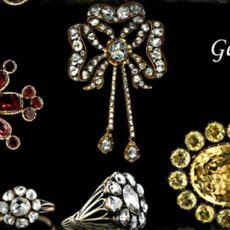
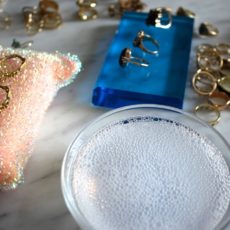
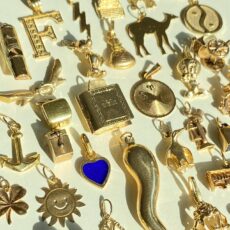
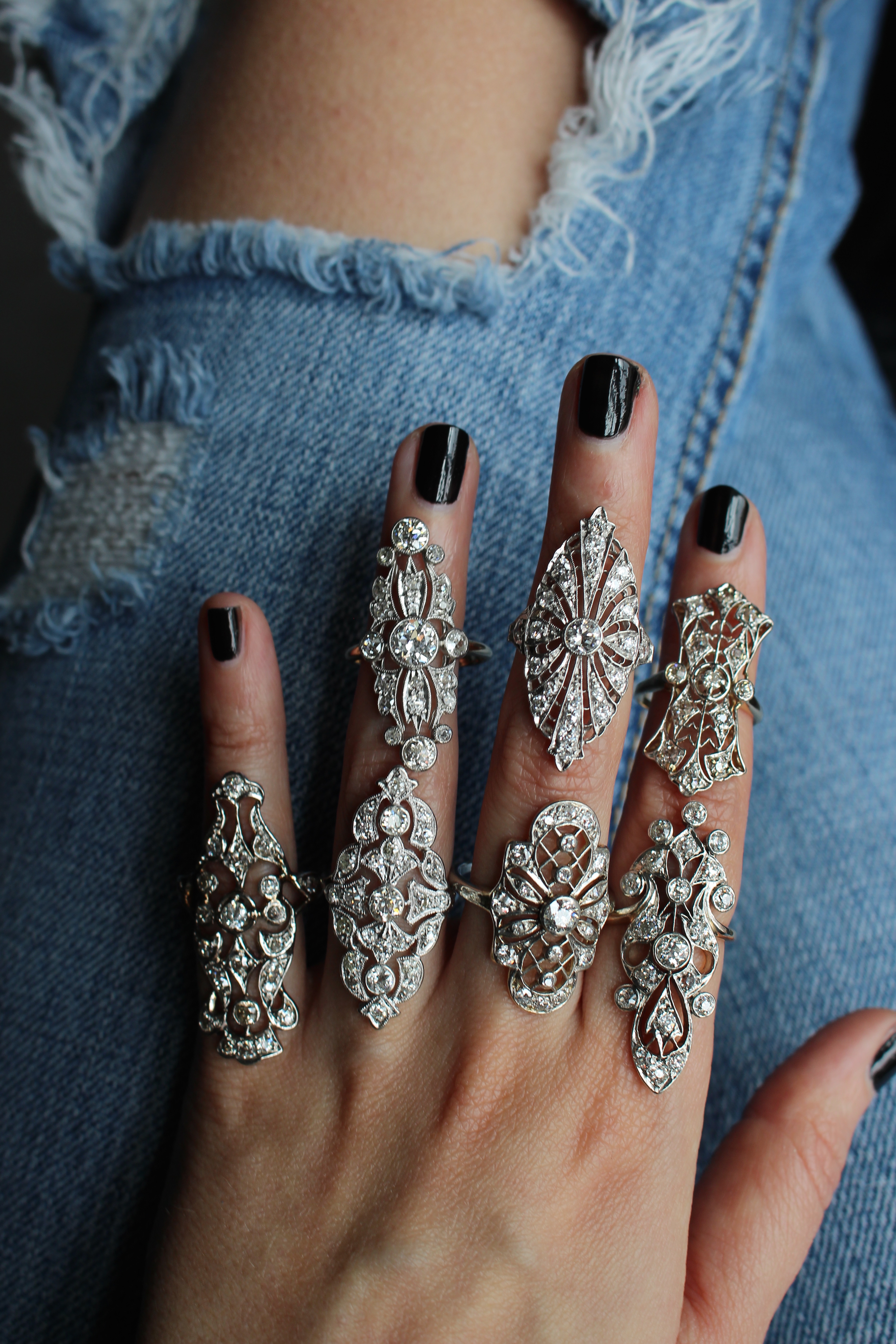
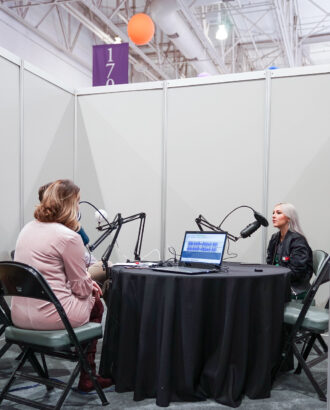
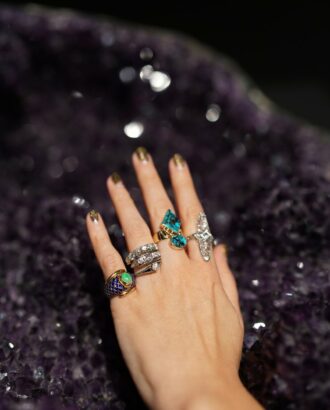

Tricia April 30, 2018 at 3:28 pm:
Great post! So informative.
Shannon May 2, 2018 at 9:06 am:
Thanks for sharing. I’ve only made it to conclave twice but it is always amazing!
D.C. Was my last Conclave and I still think of it on a weekly basis as it added so much to my being in professional and personal ways. A goal for me is to attend every year. Someday…
JHJ member!
Kathryn June 30, 2018 at 5:34 pm:
Great article, very informative. Thank you for sharing your knowledge & experience at the AGS Conclave.